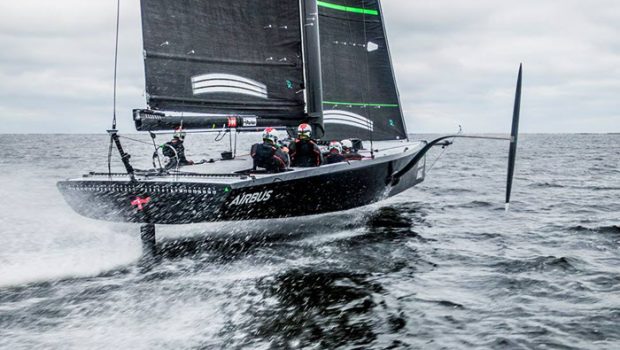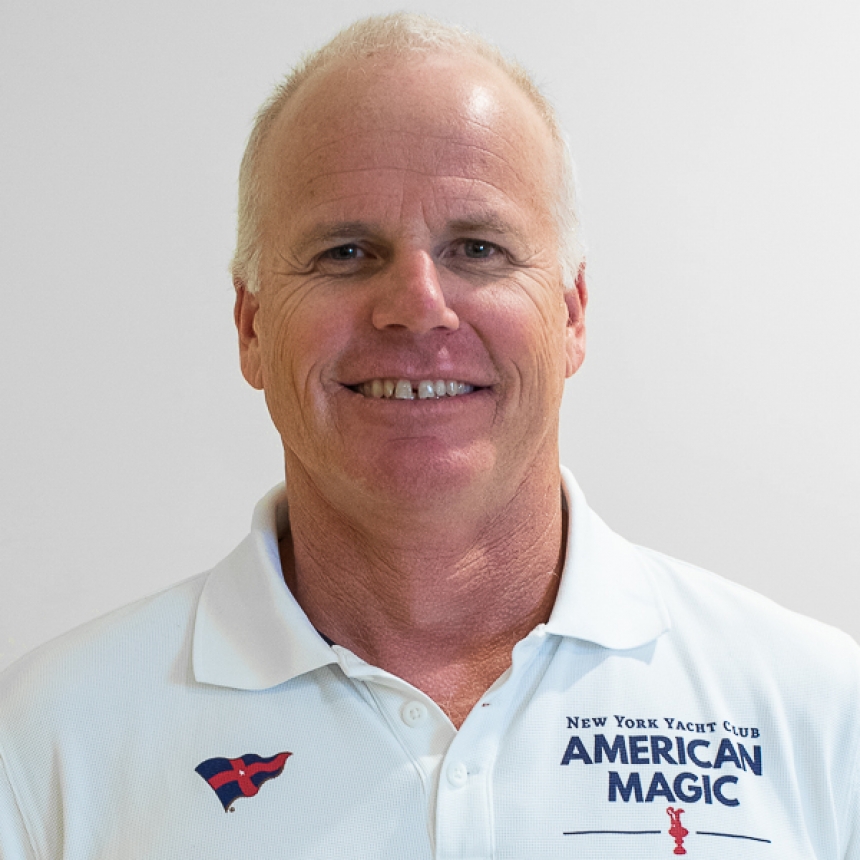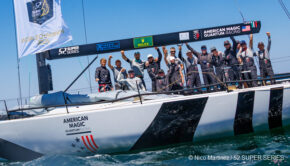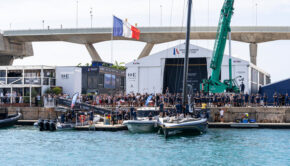Returning the America’s Cup to the USA
Published on March 17th, 2019
New York Yacht Club has been absent from the America’s Cup since the 2003 edition in Auckland, New Zealand. But now with the launch of their American Magic team, they are returning in 2021 to the event and the venue to return the trophy to 44th Street in the heart of New York City.
Scuttlebutt editor Craig Leweck checks in with Terry Hutchinson, Skipper and Executive Director, for an update.
You have been publicly operational for the past year. Hectic?
A year ago in February we were waiting for the design rule and had assembled 70% of our design team as we slowly put the pieces of the puzzle together. Fast forward to now and we are sailing our 38-foot test boat, the Mule, and having amazingly productive days on the water.
If you had said a year ago that we would be where we are today, I would have been skeptical, but today we’re operating as an America’s Cup team with a very clear vision of what we need to do over 2019, over 2020, and then again in 2021. It’s quite exciting.
There’s been three late entries. Could you imagine starting now with the same goal being 2021?
No. Our team, being new, has a major undertaking in front of us. I can’t even fathom being in this situation where you’re just now considering some of the logistical challenges, having just entered. I know what we have to face, and it is unbelievably daunting.
We are now two years out from the event, which seems like a lot of time, yet I know every single person on our team is thinking we don’t have enough time. And that’s nature of the beast. But uniquely, all the teams are in that situation. It’s not just us. If you’ve seen the challenges that we face, you can see that it’s a very real issue.
You shifted this winter from Rhode Island to Florida.
We’re full on here in Pensacola. When the Mule doesn’t sail, it’s being serviced. You realize with this operation that trying to run the Mule day in and day out is pretty hard on everybody. Where we are now, we’re not very good at managing the danger level side. What we’re learning is so exciting and shows so much potential that you want to keep sailing and sailing but that comes at a consequence to the bigger picture.
We’re certainly learning that rhythm and we’re trying to balance the sailor’s desire to get out on the water with the needs of the shore team to keep the boat going. It’s a reasonably large size operation here with 40+ personnel for the 38-foot boat. Within that there are seven sailors which gives you an idea of what it takes to go sailing.
The Mule is half the size of an AC75. How daunting will that step up be?
I can say the speed sensation on the Mule is impressive, and I suspect when we step up in size to the 75 it will have the same type of feel. You do get used to it while fully respecting how quickly a situation can get messy. We’ve made our share of mistakes like capsizing while getting off the tow the boat. What’s impressive about the boat is you’re way safer at 27 knots than you are at 7 knots. The boat generates so much stability that you feel much better in full speed mode than you do when you’re in displacement mode.
What would be a typical crash scenario?
A typical crash is generally a big nosedive with a lot of water coming over the boat and Dean (Barker) and Goody (Paul Goodison) catching it real quick with a sheet adjustment and a helm adjustment to pop the bow back up. But the crew gets pounded, it gets really wet, but that’s about the extent of it thus far.
The guys are smart in how they sail the boat and they understand its limitations so in that regard, they’ve done good work of keeping us out of vulnerable spots. That’s not to mean it’s not going to happen in the future. In actuality, we’re having the conversations about how we have to push a little bit harder. We’re getting more comfortable with it, but generally speaking, as you develop that confidence and those comfort levels it does create the potential for a situation to go a little bit wrong.
How much longer are you in Pensacola?
We’re here through the spring. I’m not going to give you an exact date because our friendly neighborhood competitors are here watching us and they have an uncanny way of knowing what we are up to. But when we do move, it will be back up to Newport, and our game plan is a little bit dependent on the AC75 foil arm delivery. This is a one design part being supplied to all the teams, so our plan will depend on how the testing goes for the foil arms. We will decide whether our training continues on The Mule or we launch and activate our first AC75.
You’re allowed to launch your first AC75 by March 31 but the foil arm development has had some delays.
The complexity of what the Defender and the Challenger of Record have taken on is aggressive, and what they’re trying to do is hard as they go through the process of designing and building the foil arms. In the early days there were structural failures and they made a conscious decision to change tack in the construction methodology and that had an effect on the schedule.
From our perspective, we have supported the process that is in place now because it was important for it to be safe for the teams, and we are respectful of what Luna Rossa and Team New Zealand have done to encourage us to participate in this regatta. This is not a small undertaking and I think all the competitors have endorsed getting a little more reliability for the boats.
Prior to this delay were you on track to launch by March 31?
Yes.
Do you see this delay as the late entries getting a break?
Not at all. We still started a year ago and I know we’re behind, so if you’re starting a year later than us, well then, you’re really behind.
What has impressed you through the design process and computer simulation for the AC75?
While it’s hard to comment on the AC75, what is impressing me thus far about the Mule is the day-in and day-out reliability and knowledge that the people that are part of American Magic have about keeping the boat out on the water.
You don’t come off the street and just say, “Yeah, I know how to do this.” That’s what stands out very clearly, sitting on the Mule and listening to how Andrew (Campbell) and Dean and Goody talk about the performance of the boat, how they’re sailing the boat, and the setup, and things that they’re processing as we’re ripping along at pace. That’s impressive to listen to.
Conversely, you come ashore and you hear Chad Turner (design) and Dan MacLean (shore team) talk about things they have to do to keep the boat going and the systems inside the boat. That’s equally is impressive, because in so many ways, it’s as important as the guys sailing the boat.
All these people have a truckload of experience in this type of boat, and having that experience is incredibly helpful. It doesn’t necessarily mean that you’re successful day in and day out but you’re mitigating some of the chances of being less successful and that’s kind of what you need.
I’m afraid I may not understand what any of these people are talking about
Yes, you and me both.
Along with the delayed launch of the AC75 is what appears to be the cancellation of the America’s Cup World Series racing in 2019. Disappointed?
I’m not really giving it a lot of thought. It is similar to the foil arms. When things that we can’t control are done to try to grow the sport, and to follow through on a mission that the Challenger of Record and Defender has, it is what it is. We entered the regatta under the existing protocol, and that was part of the Protocol, so we knew exactly what we were getting ourselves into and so you buy into it.
The Challenger of Record and the Defender have developed a Protocol which is the guiding document of the events, and not compromising on the principles of that is critical for all the teams because at a certain point, if you deviate away from it, then we lose clarity and the event loses respect. They’ve done a very good job of developing this, so when we entered, we bought into it. Is any of this perfect? Probably not but it’s equal for all the teams so that’s good and that’s what we’re after.
It’s going to be a bloody hard regatta to win and so from a competitor’s perspective, the fact that they’ve played it out to the manner that they have, in the end, that’s all we really want. What little control we have, we want to be able to control our own destiny.
We will find out for certain what the racing plan is for 2019 when they make that announcement on or before March 31, and then we will find out about the 2020 plan by the deadline on or before November 30. Again, you plan as best you can and drive our developments into a lot of that plan and understand that things will change. We have always recognized that what was set forth was an aggressive vision so we are not surprised in how executing on that has been hard.
While in this training and development stage, how do you stay in race condition?
We committed in 2018 to an active race schedule, seeing that as our year to be on the water to learn about each other, or at the very least make sure we weren’t going to implode upon ourselves when we got into pressure situations. It was great to follow through on that, and between a few of us we won three world championships as a sailing team. I’m incredibly excited by that as it’s a great demonstration of what we know we can do.
Now 2019 has to be about developing our America’s Cup boat, which will mean less racing. It’s really hard but we have to strike a balance which will mean I won’t be on the Quantum Racing TP52 for the 52 Super Series this year. However, we do have a racing plan on the Maxi 72 Bella Mente yet we always all want more, but we have a lot to look forward to with the AC75 launch. That’s what here for, and we are eager to show the world what the 36th America’s Cup will look like.
In addition to Challenges from Italy, USA, and Great Britain that were accepted during the initial entry period (January 1 to June 30, 2018), eight additional Notices of Challenge were received by the late entry deadline on November 30, 2018. Of those eight submittals, entries from Malta, USA, and The Netherlands have also been accepted. Here’s the current list:
Defender:
• Emirates Team New Zealand (NZL)
Challengers:
• Luna Rossa (ITA) – Challenger of Record
• American Magic (USA)
• INEOS Team UK (GBR)
• Malta Altus Challenge (MLT)
• Stars & Stripes Team USA (USA)
• DUTCHSAIL (NED)
Key America’s Cup dates:
✔ September 28, 2017: 36th America’s Cup Protocol released
✔ November 30, 2017: AC75 Class concepts released to key stakeholders
✔ January 1, 2018: Entries for Challengers open
✔ March 31, 2018: AC75 Class Rule published
✔ June 30, 2018: Entries for Challengers close
✔ August 31, 2018: Location of the America’s Cup Match and The PRADA Cup confirmed
✔ August 31, 2018: Specific race course area confirmed
✔ November 30, 2018: Late entries deadline
March 31, 2019: Boat 1 can be launched
2nd half of 2019: 2 x America’s Cup World Series Preliminary Events
February 1, 2020: Boat 2 can be launched
During 2020: 3 x America’s Cup World Series Preliminary Events
December 10-20, 2020: America’s Cup Christmas Race
January and February 2021: The PRADA Cup Challenger Selection Series
March 2021: The America’s Cup Match
Details: www.americascup.com









 We’ll keep your information safe.
We’ll keep your information safe.